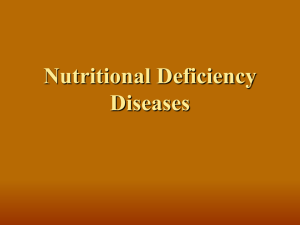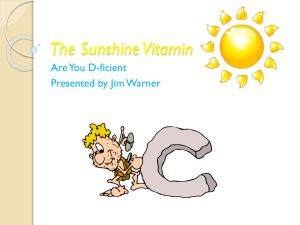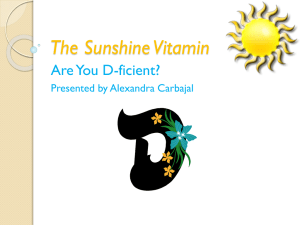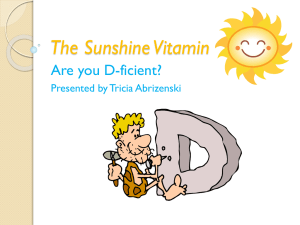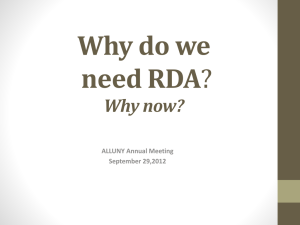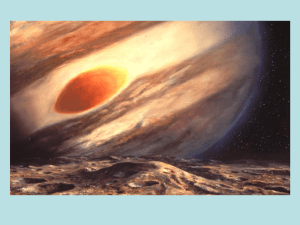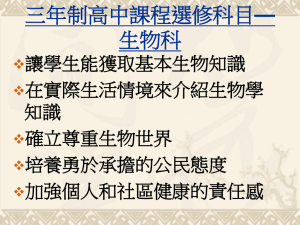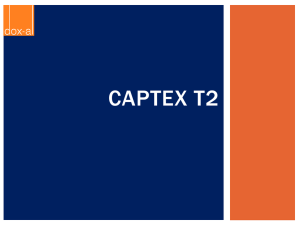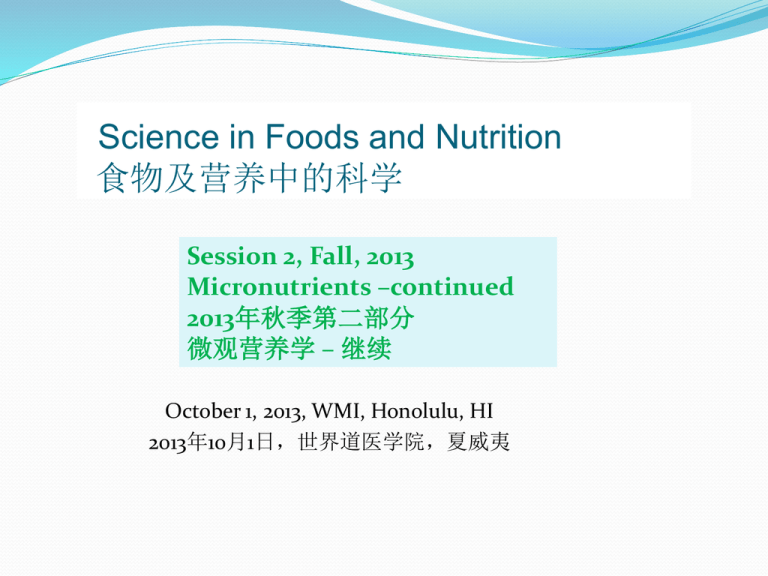
Science in Foods and Nutrition
食物及营养中的科学
Session 2, Fall, 2013
Micronutrients –continued
2013年秋季第二部分
Instructor: Cathy
Ang, Ph. D.
微观营养学
– 继续
October 1, 2013, WMI, Honolulu, HI
2013年10月1日,世界道医学院,夏威夷
Micronutrients (Micro Food Components)
微观营养素 (微观食物构成)
Water- soluble vitamins:
Vitamin C (Ascorbic acid)
Vitamin B:
Thiamin (B1),
Riboflavin (B2),
Niacin (B3),
Vitamin B6 (Pyridoxine),
Folate; folic acid
Vitamin B12 (cobalamin),
素)
Biotin (B7),
Pantothenic acid (B5)
水溶性维生素
维生素C (抗坏血酸)
维生素B:
硫胺 B1
核黄素 B2
烟酸 B3
维生素 B6
叶酸
维生素 B12(氰钴胺
Fat-soluble vitamins: A, D, E, and K
脂溶性维生素:A,D,E和K
生物素(B7)
泛酸 (B5)
Nutrient deficiency-related diseases:
缺乏相关营养素造成的疾病:
Scurvy -- bleeding gum, easy bruising, frequent infection…
from lack of …….
Vitamin C (Ascorbic acid)
坏血病 --- 牙龈出血,易受伤,易感染。。。 由于缺乏。。。
维生素C (抗坏血酸)
Beriberi – numbness and tingling in toes and feet, stiffness of the ankles,
muscular weakness …
due to the lack of ….
Thiamin (B1)
脚气病 – 脚和脚趾麻木刺痛,脚踝僵硬,肌肉瘦弱,由于缺乏维生素B1 (硫
胺)
Skin problems, red, swollen, cracked lips at the corners on mouth … due to the
lack of ………..
Riboflavin (B2),
皮肤问题,红,肿,嘴角破皮。。。 由于缺乏维生素B2(核黄素)
Nutrient deficiency-related diseases:
缺乏相关营养素造成的疾病:
Reddish skin rash, on face, hand and feet when exposed to sunlight, skin
becomes rough and dark … possibility due to the deficiency of ….
Niacin (B3),
暴露在阳光下后在脸上,手上和脚上出现微红色皮疹,皮肤变得粗糙和暗淡,可
能是由于缺乏维生素B3 (烟碱酸; 尼亚新)
Pernicious anemia (body inability to produce normal red blood cells),
may be treated with ….
Vitamin B12 (cobalamin),
严重贫血(身体无法制造正常的红细胞),可以用维生素B12(氰钴胺
素)来治疗
The risk of neural–tube defects may be reduced by getting adequate ……
Foliate; folic acid
神经管道受损的风险可以通过补充充足的叶酸来降低
Nutrient deficiency-related diseases:
缺乏相关营养素造成的疾病:
Night blindness, dry eyes and mouth, … could be due to the deficiency of ……
Vitamin A
夜盲症,眼睛和嘴巴干涩,可能的原因是由于缺乏维生素A
• Soft bones, rickets in children, osteomalacia in adults, bone pain and
tenderness and muscle weakness….
could be from the lack of …..
Vitamin D
骨骼松软,小孩驼背,成人软骨病,骨疼骨软和肌肉无力
Prolonged clotting time, easy bleeding and bruising, frequent nose bleedings …
could be a sign of deficiency in ….
Vitamin K
伤口凝血慢,易出血和淤青,经常流鼻血,可能是缺乏维生素K的征兆。
Micronutrients 微观营养元素
Minerals: Calcium (Ca), Phosphorus (P), Magnesium (Mg)
矿物质:钙Ca,硫P,镁Mg
Trace elements: Fe, Zn, I, Se, Cu, Mn (Manganese), F, Cr
(Chromium), Mo (Molybdenum)
微量元素:铁,锌,碘,硒,铜,锰,氟,铬,钼
Water and Electrolytes ( Na, K and Chloride)
水和电解质 (纳,钾和氯)
Other substances in food (examples?)
食物中的其他物质 (举例?)
建议饮食摄入量:第十版(1989)
Recommended Dietary Allowances: 10th Edition ( 1989 )
http://www.nap.edu/catalog.php?record_id=1349
***A summary table of the RDAs is attached on the e-mail.
建议摄入量总表已在邮件中发给大家
Minerals – Calcium (Ca) 矿物质 – 钙Ca
Good sources: Milk, yogurt, hard cheeses, fortified cereals, spinach, kale, tofu,
soybeans
良好来源:牛奶,酸奶,硬奶酪,强化谷物,菠菜,卷心菜,豆腐,大豆
Functions: Essential for building of bones and teeth; normal heartbeat, blood
clotting, muscle contraction, and the transmission of nerve signals…
功能:构建骨骼和牙齿,正常心跳,凝血,肌肉收缩和神经信号传导的基础物
质;
Deficiency: abnormal heartbeat; muscle pains and cramps; numbness;
dementia; stiffness and tingling of hands and feet….
缺乏:不规则心跳;肌肉疼痛和抽筋;麻木;痴呆;手脚僵硬和刺痛
RDA: 建议饮食摄入:
Adults age 19-50: 1,000 mg/day; Adults age 51 and up: 1,200 mg/day
成年人19-50:1000毫克每天;成人51岁及以上:1200毫克每天
Calcium supplements: Two most soluble forms : calcium lactate and
calcium gluconate.
钙补充:两种最易吸收的形态:乳酸钙和葡萄糖酸钙
• Excess: gastrointestinal problems, nausea, gas and constipation….
• 过量:胃肠功能问题,恶心呕吐,气体和便秘
Minerals –Magnesium (Mg)矿物质 – 镁Mg
Good sources: Green leafy vegetables, Brazil nuts, almonds, soybeans, halibut, quinoa
良好来源:绿色蔬菜,巴西豆,杏仁,大豆,比目鱼,奎奴亚藜
Functions: Helps with heart rhythm, muscle and nerve function, bone strength 功能:
有助于心脏节律,肌肉和神经功能,骨骼强度
RDA: Adult men age 19-30: 400 mg/day, Adult men age 31 and up: 420 mg/day,
Adult women age 19-30: 310 mg/day, Adult women age 31 and up: 320 mg/day,
Pregnant women: 350-360 mg/day Breastfeeding women: 310-320 mg/day
建议摄入量:成年男性19-30岁:400毫克每天,成年男性31岁和以上:420毫克每天,成
年女性19-30岁:310毫克每天,成年女性31岁和以上:320毫克每天,孕妇:350-360毫克
每天,哺乳妇女310-320毫克每天
Deficiency: loss of appetite, nausea, diarrhea, confusion, tremors, muscle cramps,
dizziness, apathy, irregular heartbeat, …
缺乏:无食欲,恶心呕吐,腹泻,思维混乱,颤动,肌肉抽筋,晕眩,缺乏激情,心律
不齐
Excess: due to abuse of magnesium-containing antacids, developes low blood pressure,
lethargy, weakness, nausea …
过量:由于滥用含有镁的抗酸剂,会产生低血压,昏睡,虚弱,恶心呕吐
For magnesium in food and water, there is no upper limit.
对于食物和水中含有的镁则没有上限
Minerals –Phosphorus (P)
矿物质 – 磷P
Good sources: Milk and other dairy products, peas, meat, eggs, some cereals, nuts,
beans, breads, dark green leafy vegetables
良好来源:牛奶及其他奶制品,豌豆,肉类,蛋类,一些谷物,坚果,豆类,面包,深
绿色蔬菜
Functions: Allows cells to function normally; takes part in most metabolic reactions;
helps the body produce energy; key in bone and teeth growth; essential element of a cell’s
genetic material and of blood fats and cell membranes; normal transmission of nerve
impulses …
功能:使细胞能够正常工作;参与绝大多数的新陈代谢反应;帮助身体产生能量;骨骼
和牙齿发育的关键元素;细胞遗传物质和血脂以及细胞壁的重要元素;普通神经传导的
物质
RDA: Adults, 700 mg/day; 建议摄入量:成人:700毫克每天
Upper limits : Adults up to age 70: 4,000 mg/day, Adults over age 70, 3,000 mg/day,
Pregnant women: 3500 mg/day Breastfeeding women: 4,000 mg/day
上限:成人70岁及以下:4000毫克每天,成人70岁以上:3000毫克每天,孕妇:3500毫
克每天,哺乳妇女:4000毫克每天
Deficiency: reduced bone mineralization, weakness, loss of appetite, muscle tremors
and bone pain …
缺乏:降低骨骼的矿化作用,虚弱,无食欲,肌肉颤动以及骨骼疼痛
Trace elements– Iron (Fe) 微量元素 – 铁Fe
Good sources: Fortified cereals, beans, lentils, nuts, beef, liver, eggs, dried fruits, dark
green leafy vegetables, ….
良好来源:强化谷物,豆类,扁豆,坚果,牛肉,肝脏,蛋类,果脯,深绿色蔬菜
Functions: Key component of red blood cells and many enzymes; involved in energy
production, …
功能:红细胞和许多酵素的关键组成元素,参与制造能量
RDA: Men: 8 mg/day, Women age 19-50: 18 mg/day, Women age 51 and up: 8 mg/day,
Pregnant women: 27 mg/day Breastfeeding women: 9 mg/day
建议摄入量:8毫克每天,女性19-50岁:18毫克每天,女性51岁及以上:8毫克每天,孕
妇:27毫克每天,哺乳妇女:9毫克每天
• Deficiency: Anemia, fatigue, rapid heartbeat, breathlessness, inability to concentrate,
disturbed sleep, severe menstrual pain and bleeding, hair loss.
•
•
•
缺乏:贫血,疲乏,心跳过快,气绝,无法集中注意力,睡眠不安,严重的痛经和出血,
脱发
Excess: most common side effect from iron supplements is constipation; high body level
of iron may be associated with risk of heart disease and possibly cancer….
过量:补铁时最常见的副作用是便秘;体内含铁量过高可能导致心脏病和癌症风险增加
Trace elements– Zinc (Zn) 微量元素 – 锌Zn
Good sources: oysters, red meats, poultry, some seafoods, wheat germ, miso
(fermented soybean paste), beans, nuts, fortified cereals,...
良好来源:牡蛎,生肉,家禽,一些海鲜,小麦胚芽,发酵大豆酱,大豆,坚
果,强化谷物
Functions: Key component of red blood cells and many enzymes; involved in
production of nucleic acid, and energy, proper wound healing, healthy skin,
strong immune system …
功能:红细胞和许多酵素的关键组成元素;参与核酸与能量的生成,愈合伤口,
•
•
•
•
健康皮肤,强化免疫系统
RDA: Men: 15 mg/day, Women 12 mg/day
建议摄入量:男15毫克每天,女12毫克每天
Deficiency: growth retardation, poor appetite, mental lethargy, delayed
wound healing,…
缺乏:生长延迟,食欲差,精神萎靡,伤口愈合慢
Excess: high dose (even 25 mg) of zinc supplementation for 6 months led to
poorer immune function….
过量:连续6个月高剂量的锌补充(即使只有25毫克)将导致免疫系统变差
Trace elements – Iodine (I)微量元素-碘I
Good sources: seaweeds (such as kelp), fish, shrimp, clams, oysters, thyroid glands of
animals and iodized salt, processed foods with added iodized salt
良好来源:海草海藻,鱼类,虾,蛤蜊,牡蛎,动物的甲状腺及碘盐,经过加工加入的
碘盐的食物
Functions: Important in the production of thyroid hormones, which serve as major
regulators of energy metabolism in body, vital for growth, reproduction, nerve formation
and mental health, bone formation…..
功能:对于甲状腺激素的生产很重要,其是身体能量代谢的主要调节剂,对于生长,生
育,神经生成,骨骼生成和心理健康非常重要
RDA: Adults: 150 mcg/day, Pregnant women: 220 mcg/day, Breastfeeding women: 290
mcg/day建议摄入量:成人:150微克每天,孕妇:220微克每天,哺乳妇女290微克每天
Deficiency: Goiter (enlargement of the thyroid), chronic fatigue, apathy, dry skin,
weight gain, intolerance to cold …
缺乏:甲状腺肿大,慢性疲劳,冷漠,皮肤干燥,体重增加,无法抵抗寒冷
Excess: different forms of iodine have different levels of toxicity. Element iodine (sold as
an antiseptic) is very toxic. Supplements contain a less toxic form – potassium iodide;
several mg of ioidne can cause thyroid problems , or inflammation of salivary glands
过量:不同形式的碘有着不同程度的毒性。作为防腐剂的纯碘毒性非常大。碘补充剂也
是有少量毒性的存在形式 – 碘化钾;及毫克的碘就可以造成甲状腺问题或者唾液腺发炎
Trace elements: Selenium (Se) 微量元素:硒Se
Good sources: vegetables (depends on how much selenium in in the soil),
such as broccoli, Brazil nuts, mushrooms, cabbages, grains; organ meats,
seafood 良好来源:蔬菜(取决于土壤中的含硒量),如西兰花,巴西豆,蘑
菇,卷心菜,谷物,动物内脏
Functions: As an antioxidant, protects cells from damage; dampen
inflammation, …
功能:作为抗氧化剂,能保护细胞不受损伤,抑制炎症
RDA: men: 70 mcg/day, women: 55 mcg/day
建议摄入量:男性:70微克每天,女性55微克每天
Upper Limit: 400 mcg/day 摄入上限:400微克每天
Deficiency: muscle pain and wasting, heart problem
缺乏:肌肉疼痛和损耗,心脏问题
Excess: fatigue, irritability and dry hair; may develop fingernail changes? hair
loss?
过量:疲劳,易怒头发干燥,可能导致指甲变化?脱发?
Trace elements –Molybdenum (Mo) 微量元素–钼Mo
Good sources: Legumes, grains, nuts, milk,
良好来源:豆荚,谷物,坚果,牛奶
Functions: Key in the production of some enzymes
功能:对于一些酵素的生成起关键作用
RDA: Adults, 45 mcg/day , Pregnant and breastfeeding women: 50
mcg/day
建议摄入量:成人:45微克每天,孕妇和哺乳妇女:50微克每天
Deficiency: rarely occur
缺乏:极为罕见
Upper limit: 2,000 mcg/day
上限:2000微克每天
Electrolytes –Sodium 电解质 – 纳
Sources: Foods to which sodium chloride (salt) has been added, like salted
meats, nuts, butter, and a vast number of processed foods
来源:添加了氯化钠(盐)的食物,如盐腌制的肉,坚果,黄油和大部分加工
食品
Functions: Important for fluid balance; moving fluids in and out of cells;
transmission of nerve impulses; heart function; and in protein and
carbohydrate metabolism,
功能:对于水液平衡很重要;搬运水进出细胞;传导神经脉冲;心脏功能;以
及蛋白质和碳水化合物的代谢
RDA (equivalent) : Adults age 19-50: 1500 mg/day , Adults age 51-70: 1,300
mg/day, Adults age 71 and up: 1,200 mg/day
建议摄入量(男女同样):成人19-50:1500毫克每天,成人51-70岁:1300毫克
每天,成人71岁及以上:1200毫克每天
Excess: sustained overconsumption of sodium, particularly as salt, has been
related to development of hypertension in sensitive individuals.
过量:持续的过量消耗纳,特别是以盐的形式,会使比较敏感的个体患上高血
压
Electrolytes – Potassium 电解质 – 钾
Natural sources: Sweet potatoes, white potatoes, yams, avocados, prunes, beet
greens, carrot juice, raisins, bananas, other fruits, yogurt, shell fish, soybeans…
自然来源:红薯,土豆,山药,鳄梨,梅干,甜菜,胡萝卜汁,葡萄干,香蕉,
其他水果,酸奶,贝壳类动物,大豆
Functions: located mostly within cells; important in maintaining normal
fluid balance; helps control blood pressure; reduces risk of kidney stones;
regulate heartbeat; energy production; muscle contraction, nerve conduction,
功能:绝大多数存在于细胞内;对于保持细胞水液平衡很重要;帮助控制血压;
减少肾结石风险;保持心率;生成能量;肌肉收缩;神经传导
RDA (equivalent): Adults: 4,700 mg/day, Breastfeeding women: 5,100
mg/day
建议摄入量(男女同):成人:4700毫克每天,哺乳妇女:5100毫克每天
Excess: misuse of supplements or salt substitutes, can result in heart failure;
muscle weakness, mental confusion; the use of potassium supplements should
be medically supervised.
过量:错误补充钾或者盐的替代品,可能导致心衰竭;肌肉无力,心理混乱;
使用补钾药品需要在医生指导下使用。
Electrolytes – Chloride 电解质 – 氯
Food sources: from table salt, sodium chloride; very small amount from
potassium chloride,
食物来源:食盐,氯化钠;也有很少一部分从氯化钾中获取
Functions: the principal inorganic anion in the extracellular fluid
compartment, essential in maintaining fluid and electrolyte balance, a
necessary component of gastric juice
功能:在细胞外液舱的主要无机阴离子,对于维持体液和电解质平衡至关重要,
是胃液的必要组成部分
Estimated requirements: the requirements specified for all age and sex
groups ecept infants parallel those of sodium
估计需求:摄入需求对于所有年龄和性别群体都有建议,除了婴儿
Excess: Sustained ingestion of high levels of chloride (as salt) has been
associated with elevated blood pressure in sensitive individuals and animal
models
过量:持续摄入高浓度的氯(以盐的形式)会导致敏感人群以及动物模型的血
压升高
Estimated Sodium, Chloride, and Potassium Minimum
Requirements of Healthy Persons
对于健康个体的纳,氯,和钾的最低估计摄入量
Vary with age and body weight 随着年龄和体重不同而不同
Range of requirements : 需求范围:
Sodium -- 120~ 500 mg/day
Chloride -- 180 ~ 750 mg/day
Potassium – 500 ~2,000 mg/day
纳 – 120 - 500毫克每天
氯 – 180 – 750毫克每天
钾 – 500 – 2000毫克每天
建议饮食摄入量:第十版(1989)
Recommended Dietary Allowances: 10th Edition ( 1989 )
http://www.nap.edu/catalog.php?record_id=1349 ; adapted from
page 253 改编自第35页
Minerals, trace elements: Cofactors are often classified as
inorganic substances that are required for, or increase the rate of,
catalysis.
矿物质,微量元素:通常被分类为无机物质,为进行催化所必需
的辅助因子,或能增加其速率
Examples of enzymes that require metal ions as cofactors
需要金属离子作为辅助因子的酵素离子:
http://academic.brooklyn.cuny.edu/biology/bio4fv/page/coenzy_.htm
cofactor辅助因子
enzyme or protein蛋白质酵素
Zn++
carbonic anhydrase碳酸酐酶
Zn++
alcohol dehydrogenase醇脱氢酶
Fe+++ or Fe++
cytochromes, hemoglobin血红素
Fe+++ or Fe++
ferredoxin铁氧化还原蛋白
Cu++ or Cu+
cytochrome oxidase细胞色素氧化酶
K+ and Mg++
pyruvate phosphokinase丙酮酸激酶
Methods on Vitamin Assay
维生素论文的思路
Physicochemical methods 理化方法
Microbiological assay 微生物论文
Animal Assay 动物论文
Stability of Nutrients 营养素的稳定性
Factors affecting the stability: temperature, light
exposure, acidity, oxygen, etc.
影响稳定性的因素:温度,光照,酸度,氧气等
Effect of food processing and preparation on
nutritional quality of food products
食品加工和制备对于营养质量的影响
Micronutrients 微量营养素
Minerals: Calcium (Ca), Phosphorus (P), Magnesium (Mg)
矿物质:钙Ca,硫P,镁Mg
Trace elements: Fe, Zn, I, Se, Cu, Mn (Manganese), F, Cr
(Chromium), Mo (Molybdenum)
微量元素:铁,锌,碘,硒,铜,锰,氟,铬,钼
Water and Electrolytes ( Na, K and Chloride)
水和电解质(纳,钾和氯)
Other substances in food (examples?)
食物中的其他物质(举例?)
建议饮食摄入量:第十版(1989)
Recommended Dietary Allowances: 10th Edition ( 1989 )
http://www.nap.edu/catalog.php?record_id=1349
***A summary table of the RDAs is attached on the e-mail.
建议饮食摄入量的表格随邮件发送
Other Substances in Food: 食物中的其他物质
“Foods contain literally thousands of organic substances presumed to have a
biological function in the plant or animal from which the food is derived or
which are by-products of the plant's or animal's metabolism”.
食物中含有数以千计的有机物质被认为是在植物或动物之中有着生物学功能
的,正是这些物质或是植物或动物新陈代谢的副产物成为了我们所说的食物
Most of these substances can be synthesized in human body, thus they are not
considered as dietary nutrients.
大多数这些物质人类身体都能制造,所以他们没有被称为摄入营养素
However, there are numerous more organic and/or inorganic substances in
foods with biological functions but have not been recognized as essential
nutrients.
但是,食物中有许多有着生物学功能的有机和/或无机物质还没有被确认为必
需的营养物质
Examples are phytochemicals. Many constituents identified from fruits and
vegetables exhibit antioxidant activities.
植物化学就是一个例子。水果和蔬菜中的许多成分都被确认具有抗氧化功能
Other Substances in Food: 食物中的其他物质
Phytochemicals: These agents include curcumin (turmeric), resveratrol (red
grapes, peanuts and berries), genistein (soybean), diallyl sulfide (allium), S-
allyl cysteine (allium), allicin (garlic), lycopene (tomato), capsaicin (red chilli),
diosgenin (fenugreek), 6-gingerol (ginger), ellagic acid (pomegranate), ursolic
acid (apple, pears, prunes), silymarin (milk thistle), anethol (anise, camphor,
and fennel), catechins (green tea), eugenol (cloves), indole-3-carbinol
(cruciferous vegetables), limonene (citrus fruits), beta carotene (carrots), …
植物化学:
这些代理商包括姜黄素(姜黄) ,白藜芦醇(红葡萄,花生和浆果) ,染料
木黄酮(大豆) ,二烯丙基三硫醚(葱) , S -烯丙基半胱氨酸(葱) ,大
蒜素(大蒜) ,番茄红素(番茄) ,辣椒素(红辣椒) ,薯蓣皂苷配基(
胡芦巴) , 6 - 姜酚(姜) ,鞣花酸(石榴) ,乌索酸(苹果,梨,李子)
,西利马林(奶,蓟) ,茴香脑(八角,樟脑,小茴香) ,儿茶酸(绿茶)
,丁香油酚,吲哚-3 - 甲醇(十字花科蔬菜) ,柠檬油精(柑橘类水果) ,
β-胡萝卜素(胡萝卜)
Reference 参考
Recommended Dietary Allowances: 10th Edition ( 1989 )
http://www.nap.edu/catalog.php?record_id=1349
http://www.webmd.com/food-recipes/guide/vitaminsand-minerals-good-food-sources
http://ods.od.nih.gov/factsheets
http://www.britannica.com/EBchecked/media/60385/Functions-of-B-
vitamin-coenzymes-in-metabolism>

